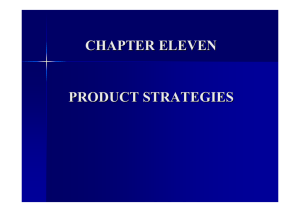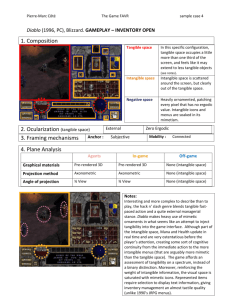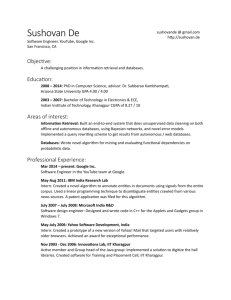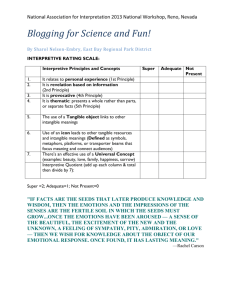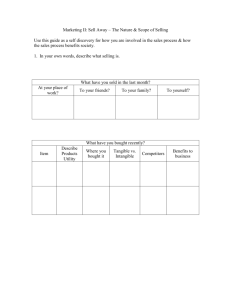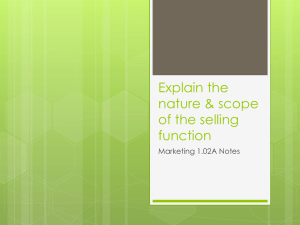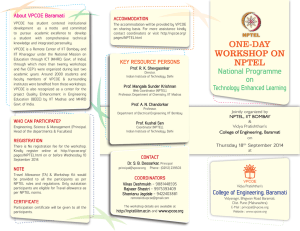Module 1 : Introduction to Services Marketing Lesson 1 Introduction
advertisement
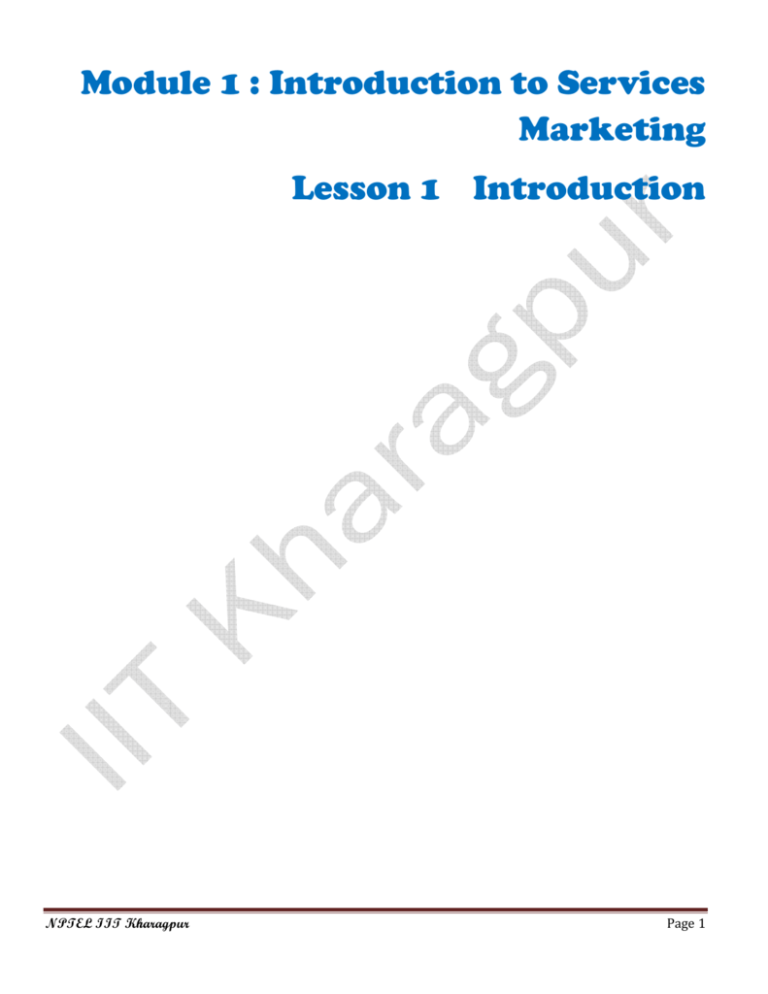
Module 1 : Introduction to Services Marketing Lesson 1 Introduction NPTEL IIT Kharagpur Page 1 Content 1.1 Introduction 1.2 Keywords 1.3 What is a Service? 1.4 Difference between Product and Service 1.5 What are the different types of services? 1.6 Concluding Remarks 1.7 Questions 1.8 Answers NPTEL IIT Kharagpur Page 2 1.1 Introduction In this lesson we will learn about the following topics: 1. 2. 3. What is a service? What is the difference between product and service? What are the different types of services? 1.2 Keywords Service, continuum 1.3 What is a Service? Let us understand what we mean by the word service. Service means a helpful activity performed for others. Say, you have to send a message to your mother whom you cannot visit for some time. Your friend listens to your message, visits your mother and gives the message to your mother. In this way, your friend undertook an activity to fulfil your need. This helpful activity of your friend is an example of service. In this example, your friend delivered the service free of cost. Alternatively, you could use postal service or SMS to deliver the message to your mother. In that case you would have to pay the price for using the service. Those services are called professional services as the shareholders and employees of those companies provide the services to earn their livelihood. Those are also examples of services undertaken for earning a profit over and above the cost of delivering the service. On the other hand several non-profit organisations provide professional services to raise the standard of living of a community. In this case the surplus money is used by the organisation to further attain their social objectives and the surplus is not redistributed among the shareholders of the company. You will learn more about the nature of services in Lesson 2. In Christopher 1.4 Difference between Product and Service You might have heard about, banking products, insurance products, etc. You have also heard about banking and insurance services. You might be wondering, what is the difference between products and services. In 1976 Adam smith wrote in his book “The Wealth of Nations, books I – III”, that products are result of productive labour while services, however honourable ... useful, or ... necessary” were the result of unproductive labour. However, in 1803 Jean-Bapliste Say argued in his book “A Tretise on Political Economy”, that production and consumption occurred simultaneously in services and therefore services were “immaterial products”. Products have been classified into four generic categories called hardware, software, processed materials and services in ISO 9000: 2000 standard. Tangible goods which can be discretely counted, like our PC, are called hardware. Intangible information like computer programs, music, etc. can be called software. Processed materials are products that can be measured on a continuous scale like oil. In ISO 9000: 2000 standard, a service has been defined as “the result of at least one activity necessarily performed at the interface between the supplier and customer that is essentially intangible”. Take the example of a haircut. The activity cannot proceed without interaction between the barber and the client. As explained in the previous section, the hair cutting activity bears the characteristic of palpable intangibility. While mining and agriculture provide natural products, manufacturing produces tangible products, and services deliver intangible benefits during servercustomer interactions. NPTEL IIT Kharagpur Page 3 Although software has been characterised as an intangible product (ISO 9000: 2000) software (information related) businesses like information technology services, architectural service, advertising service, etc. have been traditionally categorized as service businesses. All product forms including hardware, software, processed materials and services finally deliver intangible benefits to customers and are used in the service of people. For instance, a photocopier machine is used in providing photocopying services. We visit restaurants to have food, yet, we say that restaurants provide a service because the restaurant undertakes all activities to produce the food and help us consume the food. So, the restaurant provides both goods and services. In 1992, Professor Mary Jo Bitner wrote that products and services lie on a product-service continuum as illustrated in Figure 1.1. While pure products lie at the tangible end, pure services lie at the intangible end. Marketers have to focus on the tangible characteristics of products to meet the need of their customers. On the other hand service marketers have to focus more on the consumers as consumers become part and parcel of the service delivery. Bank School Clinic Airline Hotel Product‐centric TANGIBLE Fast‐Food HIGH CUSTOMER INVOLVEMENT Outlet Cosmetics Automobile Detergent Salt Soft‐drink Figure Error! No text of specified style in document..1 Product-Service Continuum 1.5 What are the different types of services? In the previous paragraph we have discussed how the service of your friend satisfied your need. How many types of needs do we have? Professor Manfred Max‐Neef classified the fundamental human needs in 1987. We can list various services that entrepreneurs like you can offer to satisfy each of the fundamental needs of people. Read this list written in Table Error! No text of specified style in document.‐1 below. NPTEL IIT Kharagpur Page 4 Table Error! No text of specified style in document.‐1 Classification of Services based on Max‐Neef’s Fundamental Human Needs Being Having Doing Interacting (qualities) (things) (actions) (settings) feed, clothe, rest, work living environment, social setting Need subsistence Types of Services physical and mental food, shelter, work health Feeding, Health care, Retail and Supply services protection care, adaptability, autonomy social security, health systems, work co‐operate, plan, take care of, help social environment, dwelling Housing, Clothing, Security, Safety, Maintenance and Insurance services affection respect, sense of humour, generosity, sensuality friendships, family, relationships with nature share, take care of, make love, express emotions privacy, intimate spaces of togetherness Friendship, Dating, Marriage and Gifting services Understand‐ ing critical capacity, curiosity, intuition analyse, study, literature, teachers, meditate, policies, educational investigate schools, families, universities, communities Education, Investigation and Meditation services participation receptiveness, dedication, sense of humour responsibilities, duties, work, rights cooperate, dissent, express opinions associations, parties, Trade, Conference, churches, Communication and neighbourhoods Travel services leisure imagination, tranquillity, spontaneity games, parties, peace of mind day‐dream, remember, relax, have fun landscapes, intimate spaces, places to be alone Entertainment services creation imagination, boldness, inventiveness, curiosity invent, build, abilities, skills, work, design, work, techniques compose, interpret spaces for expression, workshops, audiences Self‐service identity sense of belonging, self‐esteem, consistency language, religions, work, customs, values, norms places one belongs to, everyday settings Club, Association, Prayer services NPTEL IIT Kharagpur get to know oneself, grow, commit oneself Page 5 freedom autonomy, passion, self‐esteem, open‐ equal rights mindedness dissent, choose, run risks, develop awareness anywhere Justice and Enforcement services Now that we have discussed the kind of services we can offer, we have to provide these services professionally. For that, we have to learn about the management of professional services. This includes various disciplines like operations management, finance management, human resource management, information systems management and marketing management. In this subject, we will learn about managing the marketing of the services that we can offer to society to earn our livelihood. You can recollect various services that you use everyday, like, electric supply, water supply, retail, transportation, telecommunication, ATM and education services. You may be already providing some professional service to a company and earning your livelihood from the company. You must have heard people complaining about some service with which they were dissatisfied. You may have been dissatisfied with some service in the past as the service failed to satisfy you completely. You might have wondered why the company cannot provide better service. You might have further wondered what could improve the quality of a service. At the same time, you might have been satisfied with a service or even delighted with a service. We like to purchase the service from a particular service provider again and again because we are satisfied with the service offer, unless we do so because of the unavailability of any alternative. You may like to offer a service to society and make it an excellent offer that is appreciated by your customers. You will then wonder what qualities should be there in the service that you offer so that it is appreciated by your customers. At the same time, you would want to earn handsome profits from your venture so that you can grow your business year after year. In order to be able to achieve those objectives, you have to learn about services marketing. 1.6 Concluding Remarks In this lesson we have discussed what is meant by a service, what are the differences between products and services and what are the different types of services. In the next lesson we will turn our attention to what we understand various aspects of marketing of services. 1.7 Questions Q1. Write the definition of services. Q2. What are the different types of fundamental human needs that services can satisfy? Q3. Analyse the product‐service continuum illustrated in Figure 1.1. Place fire‐fighting services, car repair services and health club services on this continuum. What is the significance of the product‐service continuum? 1.8 Answers Q1. Write the definition of services. Answer: In ISO 9000: 2000 standard, a service has been deficend as “the result of at least one activity necessarily performed at the interface between the supplier and the customer that is essentially intangible” NPTEL IIT Kharagpur Page 6 Q2. What are the different types of fundamental human needs that services can satisfy? Answer: According to Professor Manfred Max‐Neef, services can satisfy nine types of fundamental human needs. These are: 1. Subsistence, 2. Protection, 3. Affection, 4. Understanding, 5. Participation, 6. Leisure, 7. Creation, 8. Identity, and 9. Freedom. Q3. Analyse the product‐service continuum illustrated in Figure 1.1. Place fire‐fighting services, car repair services and health club services on this continuum. What is the significance of the product‐service continuum? Answer: The product‐service continuum illustrated in Figure 1.1 places products and services of a graph ranging from tangible dominant to intangible dominant. It shows that customers have low involvement in the production of tangible products while they have high involvement in the production of services while have a dominant intangible component. Thus, service managers have to manage customers while they are involved in co‐producing a service, to the extent that they must be satisfied (or delighted) with their experience of service co‐production and consumption. For example, when customers have to do a range of activities in the bank or a self‐service restaurant, they must find the activities to be easy and satisfying, rather that being intriguing, difficult and irritating in nature. Fire‐fighting services can be placed at the intangible end of the continuum, while car repair services and health club services can be placed towards the intangible end as these may involve the delivery of some products like spares and health products respectively. NPTEL IIT Kharagpur Page 7

